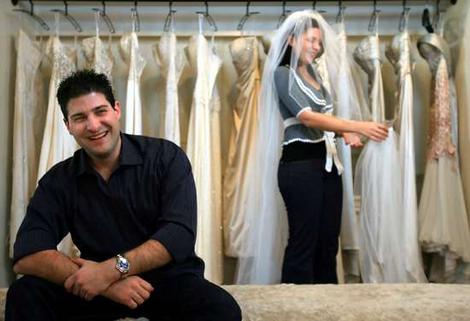
Heading for the altar: Jim Skigopoulos and Mary Kapiniaris
are bucking the trend of couples shying away from the walk down
the aisle.
Photo: Wayne Taylor
Australians swap I do for I don't

Heading for the altar: Jim Skigopoulos and Mary Kapiniaris
are bucking the trend of couples shying away from the walk down
the aisle.
Photo: Wayne Taylor
Farah Farouque
After the Greek Orthodox ceremony, recited in an old dialect, they will walk ritually in a circle together to symbolise their togetherness.
"It's the part I'm really looking forward to," Ms Kapiniaris says. "It represents the first steps you take after marriage."
But an exclusive analysis of new census data for The Age by Monash University's Centre for Population and Urban Research shows how fewer and fewer Australian are taking those steps, in a demographic sense.
While de facto relationships have crept up in the past decade, the data points to continued falls in the proportion of formal marriage in age groups from the early 20s to mid-40s for both men and women.
Between 30 and 34, for example, the proportion of married men has fallen to 49 per cent from 57 per cent 10 years ago. Just over a third of women between 25 and 29 are now married, compared to nearly half in 1996.
"There's been a relentless decline in marriage, although fertility depends on partnering, especially married partnering," says demographer Bob Birrell.
The analysis builds on earlier work tracking large declines in overall partnering since the mid-1980s.
Dr Birrell says the social relationship for a female in a couple family — marriage or de facto status — is an important indication of fertility levels.
The data shows striking differences between fertility of wives — who have more children — and live-in partners, which suggest a different calibre of relationship might be struck in those relationships.
Between 40 and 44, nearly a quarter of women in de facto relationships, for example, had no children. Only 8 per cent of wives in this category, however, were childless and this was likely to reflect infertility rather than choice, according to the research.
It also shows that despite recent increases in birth numbers and debate about a "mini baby boom", there is still a long-term decline in the mean number of children born per woman across the reproductive years. Two children remain the common number per woman.
Children are a possibility "in a few years" for Ms Kapiniaris, 24, a public servant, and Mr Skigopoulos, 32, an engineer.
The way they have come to the altar harks back to a more traditional model of coupling than prevails for most people today. They have not lived together, which is the overwhelming experience of most people, although in Australia a de facto relationship is still an interregnum before formal marriage or a break-up.
Is marriage in crisis?
"The vast majority of people still get married," says Australian National University demographer Peter McDonald. He rejects alarmist views about its future. "Crisis is a big word … the fall in partnering and marriage is just something that has to be managed."
Mr Skigopoulos for one is faintly amused that some might suggest he is joining an endangered institution.
"I am a great believer in marriage. I've always thought it was the right way to go for me. It's a way of life, a way to start a family."